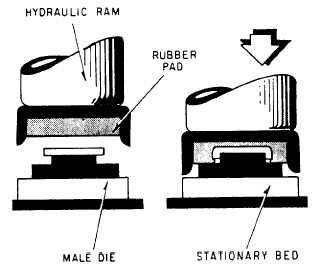Figure 1-24.—Guerin process.
easily; precautions must be taken to avoid this if
possible. If they are ignited, you should extinguish them
immediate y with an extinguishing powder such as
powdered soapstone, clean, dry, unrusted cast iron
chips, or graphite powder.
Water or any
CAUTION
standard liquid or foam
extinguisher causes magnesium to burn more
rapidly and may cause small explosions.
SUBSTITUTION AND
INTERCHANGEABILITY
OF AIRCRAFT METALS
In selecting interchangeable or substitute materials
for the repair and maintenance of naval aircraft, it is
important that you check the appropriate aeronautic
technical publications when specified materials are not
in stock or not obtainable from another source. It is
impossible to determine if another material is as strong
as the original by mere observation. There are four
requirements that you must keep in mind in this
selection. The first and most important of these is
maintaining the original strength of the structure. The
other three are maintaining contour or aerodynamic
smoothness, maintaining original weight, if possible, or
keeping added weight to a minimum, and maintaining
the original corrosive-resistant properties of the metal.
Because different manufacturers design structural
members to meet various load requirements, you can
appreciate the importance of checking the specific
technical publication. Structural repair of these
members, apparently similar in construction, will thus
vary in their load-carrying design with different aircraft.
Structural repair instructions, including tables of
interchangeability and substitution for ferrous and
nonferrous metals and their specifications for all types
of aircraft used by the Navy, are normally prepared by
the contractor. Such instructions are usually contained
in the NA 01-XXX-3 manual covering structural repair
instructions for specific models of aircraft. Similar
information is also contained in General Manual for
Structural Repair, NA 01-1A-1.
Aerospace Metals-General Data and Usage
Factors, NA 01-1A-9, provides precise data on specific
metals to assist in selection, usage, and processing for
fabrication and repair.
Always consult these publications and the NA
01-XXX-3 aircraft manual for the specific type of
aircraft when confronted with a problem concerning
maintenance and repair involving substitution and
interchangeability of aircraft structural metals. Be sure
you have the most recent issue of the aeronautic
technical publication.
HARDNESS TESTING
Learning Objective: Recognize hardness
testing methods, related equipments, and their
operation
Hardness testing is a method of determining the
results of heat treatment as well as the state of a metal
prior to heat treatment. Since hardness values can be tied
in with tensile strength values and, in part, with wear
resistance, hardness tests are an invaluable check of
heat-treatment control and of material properties.
Practically all hardness testing equipments now in
service use the resistance to penetration as a measure of
hardness. Included among the better known bench-type
hardness testers are the Brinell and the Rockwell, both
of which are described and illustrated in this section.
Also included are three portable type hardness testers
now being used by maintenance activities.
1-35


